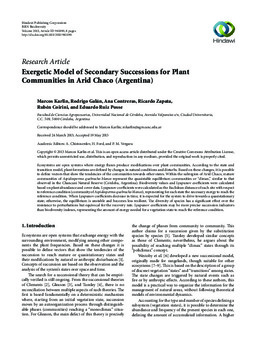| dc.contributor.author | Karlin, Marcos Sebastián | |
| dc.contributor.author | Galán, Rodrigo | |
| dc.contributor.author | Contreras, Ana Marina | |
| dc.contributor.author | Zapata, Ricardo Miguel | |
| dc.contributor.author | Coirini, Rubén O. | |
| dc.contributor.author | Ruiz Posse, Eduardo Juan | |
| dc.date.accessioned | 2022-05-16T13:39:41Z | |
| dc.date.available | 2022-05-16T13:39:41Z | |
| dc.date.issued | 2013 | |
| dc.identifier.citation | Karlin, M. S., Galán, R., Contreras, A. M., Zapata, R. M., Coirini, R. O. and Ruiz Posse, E. J. (2013). Exergetic Model of Secondary Successions for Plant Communities in Arid Chaco (Argentina). International Scholarly Research Notices, 2013, 1-8. https://doi.org/10.1155/2013/945190 | |
| dc.identifier.uri | http://hdl.handle.net/11086/24925 | |
| dc.identifier.uri | https://doi.org/10.1155/2013/945190 | |
| dc.description.abstract | Ecosystems are open systems where energy fluxes produce modifications over plant communities. According to the state and
transition model, plant formations are defined by changes in natural conditions and disturbs. Based on these changes, it is possible to define vectors that show the tendencies of the communities towards other states. Within the subregion of Arid Chaco, mature communities of Aspidosperma quebracho blanco represent the quasistable equilibrium communities or “climax,” similar to that observed in the Chancaní Natural Reserve (Córdoba, Argentina). Biodiversity values and Lyapunov coefficients were calculated based on plant abundance and cover data. Lyapunov coefficients were calculated as the Euclidean distance of each site with respect to reference condition (community of Aspidosperma quebracho blanco), representing for each state the necessary exergy to reach the reference condition.When Lyapunov coefficients decrease in time, it is expected for the system to drive towards a quasistationary state; otherwise, the equilibrium is unstable and becomes less resilient. The diversity of species has a significant effect over the resistance to perturbations but equivocal for the recovery rate. Lyapunov coefficients may be more precise succession indicators than biodiversity indexes, representing the amount of exergy needed for a vegetation state to reach the reference condition. | en |
| dc.language.iso | eng | es |
| dc.rights | Atribución 4.0 Internacional | * |
| dc.rights.uri | http://creativecommons.org/licenses/by/4.0/ | * |
| dc.source | International Scholarly Research Notices, 2013; 2013, 1-8 | |
| dc.source | ISSN: 2356-7872 | |
| dc.source.uri | https://www.hindawi.com/journals/isrn/ | |
| dc.subject | Región Chaqueña | es |
| dc.subject | Zona árida | es |
| dc.subject | Ecología | es |
| dc.subject | Biodiversidad | es |
| dc.subject | Comunidades vegetales | es |
| dc.subject | Argentina | es |
| dc.title | Exergetic model of secondary successions for plant communities in Arid Chaco (Argentina) | es |
| dc.type | article | es |
| dc.description.version | publishedVersion | es |
| dc.description.fil | Fil: Karlin, Marcos Sebastián. Universidad Nacional de Córdoba. Facultad de Ciencias Agropecuarias; Argentina. | es |
| dc.description.fil | Fil: Galán, Rodrigo. Universidad Nacional de Córdoba. Facultad de Ciencias Agropecuarias; Argentina. | es |
| dc.description.fil | Fil: Contreras, Ana Marina. Universidad Nacional de Córdoba. Facultad de Ciencias Agropecuarias; Argentina. | es |
| dc.description.fil | Fil: Zapata, Ricardo Miguel. Universidad Nacional de Córdoba. Facultad de Ciencias Agropecuarias; Argentina. | es |
| dc.description.fil | Fil: Coirini, Rubén O. Universidad Nacional de Córdoba. Facultad de Ciencias Agropecuarias; Argentina. | es |
| dc.description.fil | Fil: Ruiz Posse, Eduardo Juan. Universidad Nacional de Córdoba. Facultad de Ciencias Agropecuarias; Argentina. | es |





